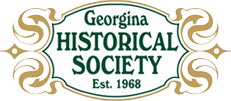Click to Download the PDF
Download the Word Doc
President’s Message
Welcome to the October 2024 newsletter, our editor Bob Holden has another good one for you, and I have lots of news to share.
Harvestfest 2024 is behind us, and although attendance was down from 2023, we still had a successful day. I want to thank all of our volunteers who came out despite the forecast of rain; it always amazes me to see the smiling faces and helping hands willing to pitch in. From the earliest planning stages, permit applications that must be made to the Town of Georgina and the Region of York, lining up vendors and musical talent, to coming out a few days before to decorate the Georgina Pioneer Village in preparation for the event, and finally the big day, thanks to you all, you can be very proud of what we accomplished!
I’m pleased to let you know that Bonnie Park/Lorne Park, aka Jackson’s Point Park, has been recognized as a heritage property by the Town. Council has directed staff to proceed with the Heritage Designation for the park, which should preserve this direct lakefront, 2.82 acre park as a right of way to the lake for future generations. I also want you to know that Heritage Designation for the Jackson’s Point Wharf Marine Railway is in the works, and should be completed by years end. Thanks to our Town Council for recognizing the historical importance of these properties.
On the subject of historic properties in the Town of Georgina, Giaimo Architects has been working on the list of heritage properties, cleaning it up, dropping off properties that aren’t deemed historically significant, and recommending significant properties to be brought forward for Heritage Designation. This is a big job, and they have until the end of the year to complete their mandate. The Province of Ontario has extended the deadline, but Giaimo is committed to finish by year’s end.
I also want to remind you that before our upcoming October General Meeting there will be a short special meeting to vote on the GHS by-law changes. These changes are required by legislation known as the Ontario Not-for-profit Corporations Act (ONCA).
To bring you up to date on the cemetery rehab being carried out by the Town of Georgina, we have a story for you about work being done at the Mann-Sprague Cemetery in Keswick. You will be interested to know that our featured guest at the October General Meeting will be the co-ordinator of the cemetery re-hab project, Courtney Rennie, to explain the project, to tell us what has happened to date, and about next steps.
And finally, please plan to attend our Annual General Meeting on November 21st at the Sutton Legion. Meet and greet starts at 5:30, supper at 6, and we are excited to present Dan Buchanan, author of the book “Wreck of the HMS Speedy”, as our speaker for the evening. Dan puts on a great presentation that I’m sure you will enjoy. Further details are in the newsletter.
I’m looking forward to seeing you all on the evening of October 15 at the schoolhouse at the Georgina Pioneer Village.
Bye for now, Paul.
Mail Services; a History – Part 1
By Bob Holden
What is the image of Benjamin Franklin, a father of the nation on our southern border and signer to their Declaration of Independence, doing on a Canadian stamp? Everything!! He was one of two Deputy Postmaster Generals for the North American colonies in 1753. The mail services we take for granted today are very different from the earliest days of settlement. Private mail sent from one place to another was entrusted to travellers willing to carry it as a favour; fur-trade voyageurs travelling the Upper Country conveyed it into remote areas; mail aboard ships sailing local waterways and oceans was carried by officials or colonists doing business at their destinations.
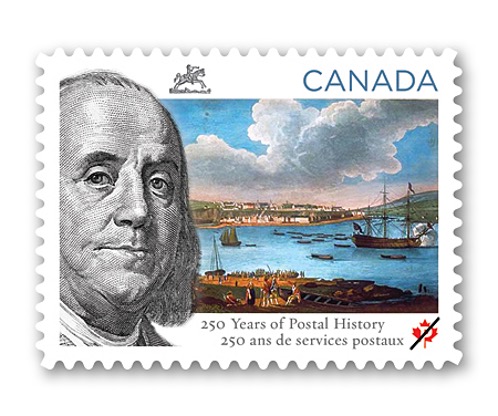
Merchants exchanged letters, credit notes and inventory orders with suppliers across the Atlantic via agents in New York and later, Montreal and other ports, carrying them as incoming and outgoing mail between the Canadas and Britain or Europe, and ensuring they were properly forwarded via the appropriate vessels to and from the colonies. Within the colonies, merchants, bishops, priests and others handed their letters over to couriers and sometimes, their correspondence was sent through a middleman handling mail for them instead of a post office.
Thus, early postal systems were more often an informal network between letter writers and their delivery agents linked to each other all along trade and transport routes. This was not new to the Canadian colonies and probably dates back to pre-colonial times in Europe. It became the basis of business information processing throughout the world economy well into the nineteenth century.
Sending letters via another person was only one aspect of a larger tradition in sending and making letters. Letter writers would fashion writing quills from goose feathers. There was no delete button, as with a modern computer; removing unwanted mistakes had to be scratched from the page with a sharp-edged eraser such as a pumice stone. Once written, the letter was hand folded (envelopes were not used) and sealed. Sealing wax, usually red (black was for funerals), was melted by candle flame onto the line of the fold. Then a personal imprint was stamped on the wax. Thus the letter writer had a hand in every step of the process. When the letter arrived at its destination, they were passed from hand to hand and often read out loud to the family. On occasion, notes were jotted on the outside of the cover as the letter headed to the next recipient.
In 1753, Postal services were more formalized when Benjamin Franklin was appointed as one of two deputy postmasters general for the British colonies. In 1755, Franklin organized the first regular monthly mail packet service between Falmouth, England, and New York. He opened the first official post office in Canada at Halifax, Nova Scotia, to link Halifax with the Atlantic colonies and the packet service to England. A post office for local and outgoing mail had been started by Benjamin Leigh in Halifax in April 1754.
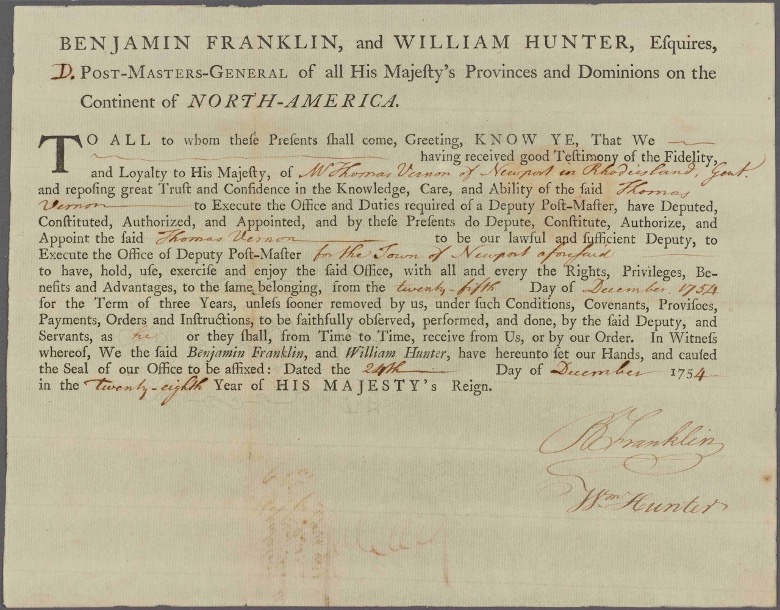
After 1763, Franklin established another post office in Québec City, with subsidiaries in Montréal and Trois-Rivières. Hugh Finlay, a Scottish immigrant, became postmaster. A monthly courier service by way of Lake Champlain connected Montréal with New York and the Atlantic packet service. In 1774, Franklin was dismissed because of sympathies with the American revolutionary cause, and Finlay became deputy postmaster general for the northern colonies. By 1775, most mails were seriously disrupted by the revolutionaries. Finlay stopped inland services because of the threat to the couriers’ lives. The Revolutionary War ended in 1783; and, on July 7th 1784, Hugh Finlay became the deputy postmaster general for Canada. The revolution brought a major immigration of Loyalists to Canada and a demand for improved postal services. In 1784, Finlay hired a courier, Pierre Durand, to pioneer a Canadian route to Halifax from Québec City through 1,000 km of forest. The round trip with the mail took 15 weeks. The disruptions to mail services by the American Revolutionary War showed the weakness in not having an all-British route between Canada and Halifax, Nova Scotia. In 1787 complicated mail routes were set up through Rivières du Loup, Fredericton, Digby, and Annapolis. Upper Canada had its own semi-monthly route through Kingston, Niagara, Detroit, and as far as Michilimackinac on Lake Huron.
In 1791 the British Parliament divided the Province of Quebec into Upper Canada and Lower Canada. This division continued until 1841, when the Union Act re-united the two provinces as the Province of Canada.
On 17 March 1792, Timothy Pickering, Postmaster General of the United States, proposed to the first postal convention between the Canadas and the United States. This convention was recognized as the first attempt to facilitate the international handling of mail whereby one country accepts the prepaid correspondence of another. By the terms of the convention, mail from Great Britain destined for the colonies would be routed through New York City to Burlington, Vermont, and then on to Montréal. Conversely, mail from colonies destined for Great Britain is shipped from New York City. The proposal was accepted and the agreement continued until 1794. Although its terms remain in force during subsequent years there was no immediate new agreement. British mail received at New York for the Canadas was sent in sealed bags by the New York Postmaster to Burlington, Vermont, where it was met by the Canadian courier who brought it into Montréal every 14 days. By 1798, a stagecoach serving Newark (Niagara) and Chippewa three times a week transported not only passengers but mail as well.
It was in 1799 when George Heriot was appointed as Deputy Postmaster General for the Provinces of Upper and Lower Canada, Nova Scotia and New Brunswick in North America and other dependencies. Heriot assumed office in April 1800. Frustrated by inflexible postal regulations, Heriot improved and expanded services to the isolated and rapidly expanding southwestern section of Upper Canada. Beginning in December 1800, Heriot increased winter service to Niagara from one delivery during the entire season to one delivery per month; additional couriers were placed on the Montréal-Kingston route.
Postal services to Upper Canada were improved in 1811 when couriers were dispatched once a fortnight between Montréal, and Kingston Upper Canada throughout the year; another courier between Kingston and York (Toronto) was dispatched once a fortnight during the winter closing of navigation on Lake Ontario. By 1817 mails were running between Upper Canada twice a week; between Kingston and York once a week; between York and Niagara once a week; between York and Amherstburgh once a fortnight; by 1820 there are 1919 post offices in Upper Canada. Early in 1831, mail services between Montréal and Niagara, known as the Grand Route, were increased to five times a week.
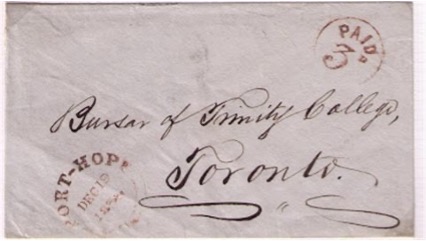
Left – Prior to the creation of adhesive stamps, post-masters would hand strike letters and collect cash. Adhesive stamps were appreciated by postmasters as they had to cut individual stamps from a sheet, sell it to customer, then stamp it with a cancellation mark. They would then claim a commission on stamps sold but as it was time consuming and with the time delay factor, they continued to prefer the simpler bookkeeping alternative of collecting cash and hand cancelling letters. This remained a relatively common practice for almost 25 years until adhesive stamps were made mandatory under the new Post Office Act in 1875, several years after the formation of the new country of Canada.
In pioneer times, mail would have been carried by individuals who volunteered to carry letters for friends or by teamsters and coachmen as they made their way on their travels about the colony. Mail would have been left at a central location within a community, usually an inn, tavern, or general store; a place where the recipient would be most like to visit on a regular basis. It wasn’t until after the first decades of the nineteenth when postal contracts were let to stagecoach companies to carry the Royal Mail. Even so, local distribution could be problematic due to the wide dispersal of clearings and relatively few towns, villages and cross-road settlements. At first post offices were only located in the largest cities for distribution by informal couriers to the outlying settlements. But as roads and communications improved, post offices were installed in the larger or busier towns and villages beyond the cities and by the time of Confederation in 1867 there were over 2600 post offices throughout the new Dominion.
Mail Services; a History – Part 2 will follow in the November issue of the newsletter covering our postal system to the end of the nineteenth century.
Sources:
https://en.wikipedia.org/wiki/Postage_stamps_and_postal_history_of_Canada
https://www.historymuseum.ca/cmc/exhibitions/cpm/chrono/chs1841e.html
Mann-Sprague Cemetery Improvements
By Paul Brady and Bob Holden
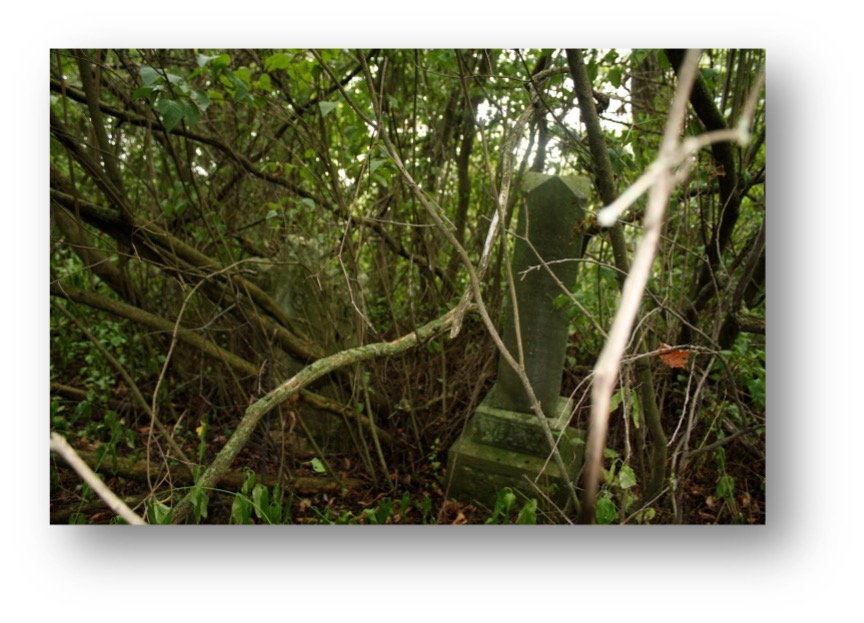
His quest was covered in an article in the Advance and candid comments were made about the poor condition of the cemetery. As early cemeteries go, this one is rather large with over 180 graves. When a cemetery is closed to further use, as this one had been, it is the municipality that is required to maintain it. Until recently, the Town of Georgina had been remiss in this responsibility.
Recently Paul and I have both visited this cemetery and were astonished at the wonderful progress made since the cemetery report was completed. All the brush and saplings have been removed and the markers and grave stones repaired and reset as much as possible. Thanks and kudos must be given to Courtney Rennie, the Town’s Co-ordinator for this project, and to the work team from Memorial Restorations Inc. of Sarnia. Well done! Courtney will be our guest speaker at our meeting on Tuesday October 15th to discuss the cemetery report and future plans for rehabilitation of our pioneer cemeteries. It should be a very interesting presentation.
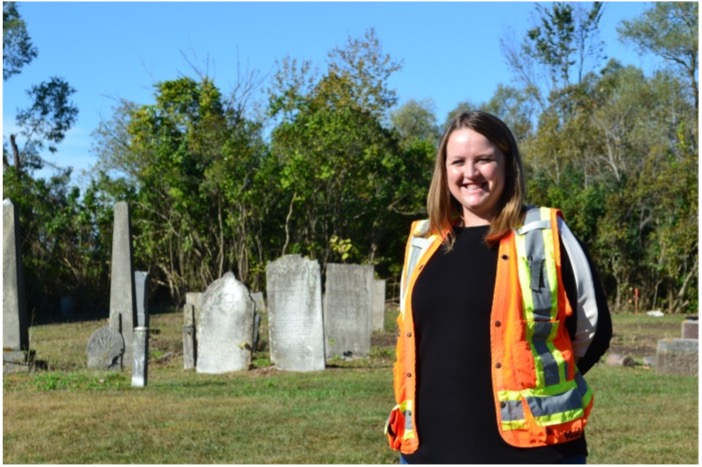
Courtney Rennie, Cemetery Rehabilitation Co-ordinator, and a view of the rehabilitated Mann-Sprague Cemetery.
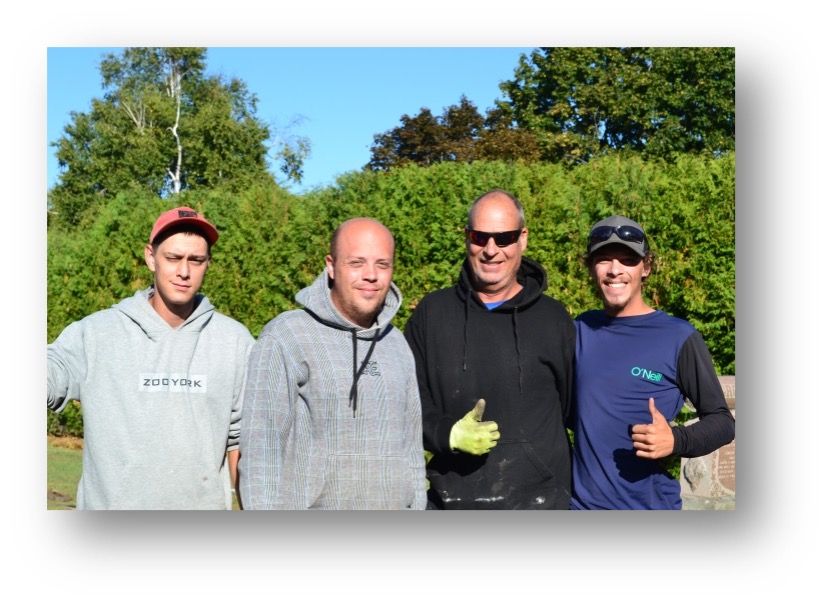
Memorial Restorations Inc. team, Tim Klassen, third from the left, is President of the company, which is based in Sarnia.
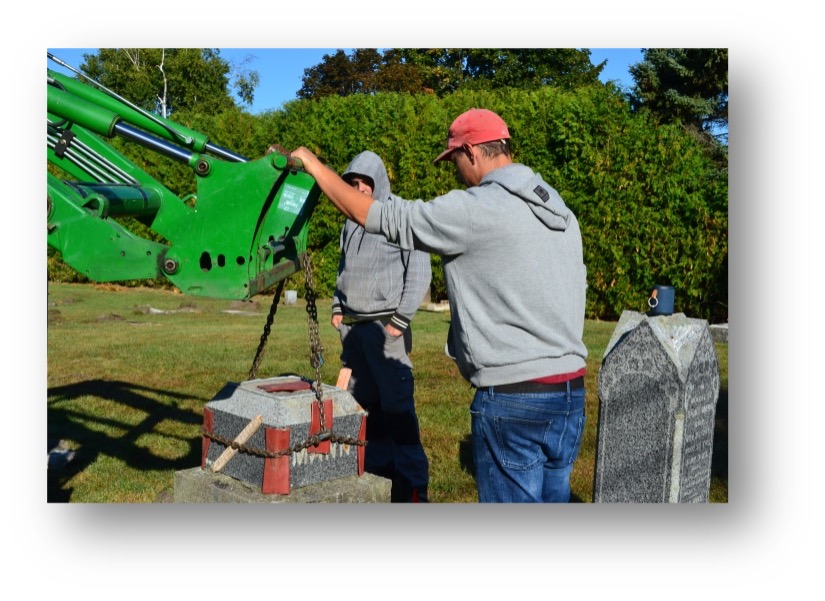
The team carefully lifts the base up, leveled it with gravel, then reassembled the monument.
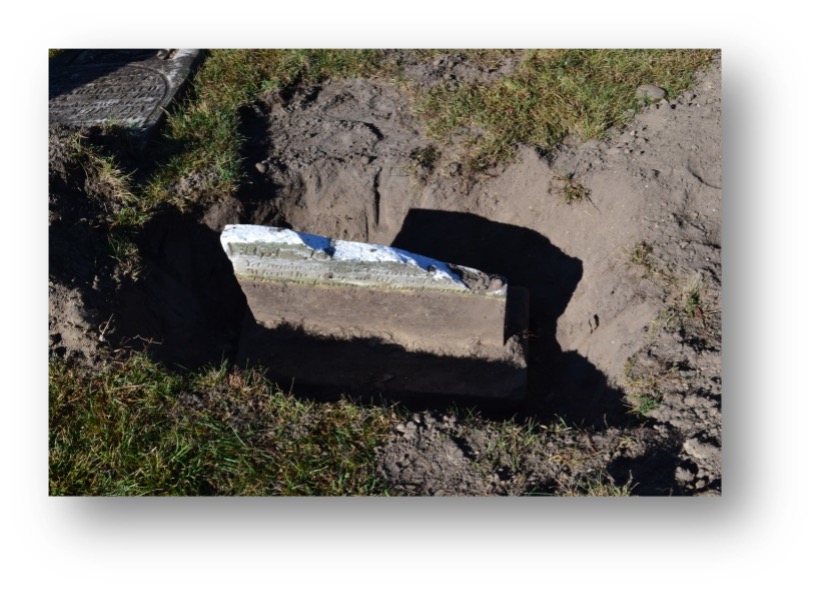
Some monuments were sunk as deep as four feet.

Another example of a buried marker
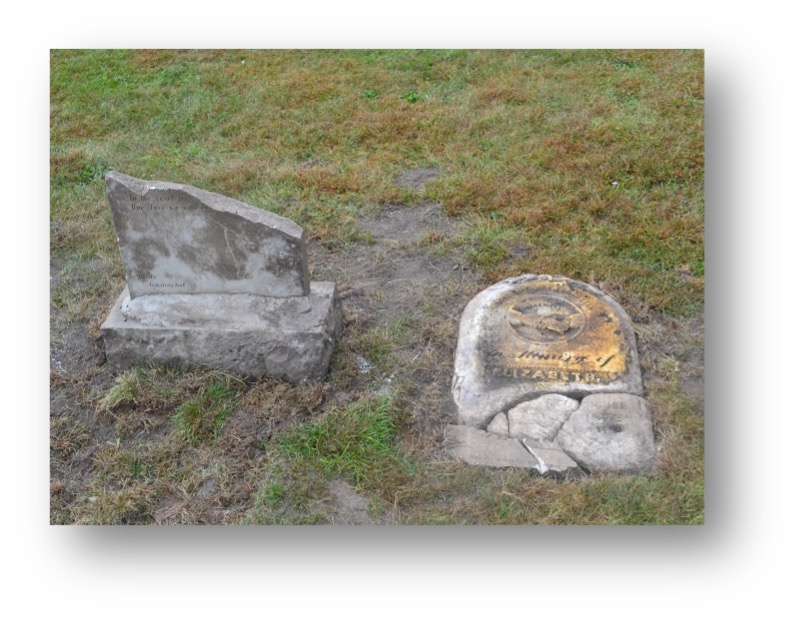
Some markers were so damaged that they were unable to be put back, so they were respectfully cleaned and preserved as best they could be.
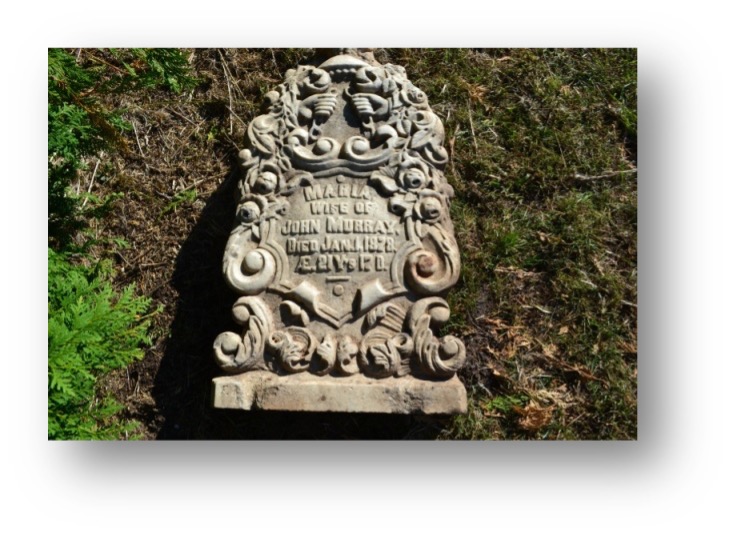
This beautiful monument was found face down under the hedge on the northern-most edge of the cemetery.
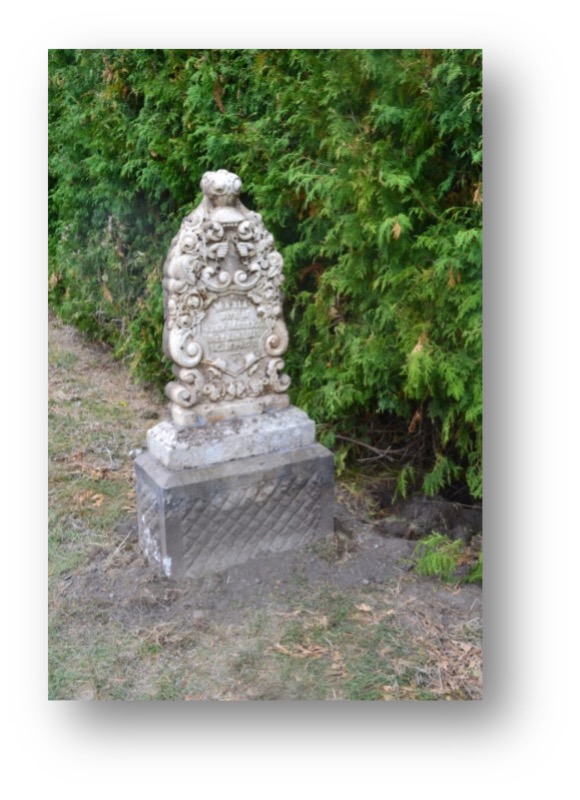
And here it is back on it’s base, cleaned and straightened, honoring Maria, wife of John Murray, died January 1, 1878, aged 21 years, 17 days.
Where in Georgina?
Our previous mystery location was identified correctly by our President Paul Brady. Thanks Paul! It’s finally solved…it was the Orchard Beach General Store! We have a new mystery location below …where is it, and what is it?
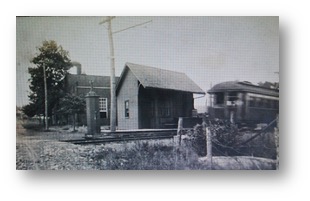
Our Pioneer Ancestors
Postmasters were an important part of every community, especially in pioneer times. Here are the listing for post offices and postmasters for the townships that made up our Town of Georgina in Lovell’s Canada Directory of 1851. There were only four listed at that time.
Post offices in N Gwillimbury
Belhaven – Daniel Prosser, Postmaster
Keswick/Medina – Henry Stennett, Postmaster
Post offices in Georgina
Georgina/Sutton – J. O. B. Bourchier, Postmaster
Pefferlaw – George Johnson, Postmaster
News
There’s lots of news for you this month; as you may have heard, our President, Paul Brady, has been appointed to the Ad Hoc Committee of the Georgina Heritage Advisory Committee, along with Dee Lawrence, Karen Wolfe, Allan Morton and Terry Russell. The Ad Hoc Committee was chosen to help the consulting firm Giaimo Architects update Georgina’s Heritage List and proceed with Heritage Designations for worthy properties. There has been one meeting with the Town and the consultant, and another meeting with the Ad Hoc Committee, with another meeting with the consultant coming up soon. There should have some news for you on this important initiative by the end of the year.
Work has started at the Mann Cemetery. Courtney Rennie at the Town of Georgina, the person looking after this project, was contacted and asked if she would be interested in speaking to us at our October general meeting. She has accepted our invitation; thanks Courtney, we’re looking forward to seeing you.
Bonnie Park/Lorne Park has been approved by the Georgina Town council for approval to receive its Heritage Designation. We have also been assured that the Jackson’s Point Wharf Marine Railway will be brought forward for Heritage Designation this fall. We are especially excited to see this historic site receive its due recognition, and will be bringing updates on this as the process unfolds.
Dan Buchanan, author and historian, will be our speaker at the Annual General Meeting, being held at the Sutton Legion on Thursday November 21st. Save the date, you won’t want to miss this meeting. Dan will be telling the story of the wreck of the schooner HMS Speedy in 1804, an incident that shook Upper Canada. His book on that subject will be available for purchase. Meet & Greet eill be at 5:30 P.M. and a roast beef dinner will follow at $30.00 per person. Don’t forget that membership renewals will be coming due as well.
Our next general meeting will be next Tuesday, October 15th at the schoolhouse in the Village. Courtney Rennie will present information on the Town of Georgina’s Cemetery Report and the plans for rehabilitate of our early cemeteries. She will updte us on the Mann-Sprague Cemetery as well. It should be an interesting evening. There will also be a very short meeting prior to her presentation regarding changes to our constitution as required by the provincial government from all non-profit organization. This review and subsequent changes were completed in your Board’s meeting on September 9th and have been examined and approved by our lawyer. It must be presented to you the membership for ratification before we send it off to the provincial government before their deadline.
Help! – Volunteers are needed to assist with events and programming in the Georgina Pioneer Village. Please contact Melissa Matt at 905-476-4301 Ext. 2284 or at georginapioneervillage.ca.
Events
October 19th – Family Fright Fiesta at the Village – see poster on last page before Contacts
October 25th (a Friday) and October 28th (Monday) – Georgina Two Dark Nights; 2 sessions per night; from 6:30 – 8:00 PM and 8:30 – 10:00 PM; contact Melissa Matt at the Village at905-476-4301 Ext. 2284 or at georginapioneervillage.ca. for more information.
Tuesday, October 15th – at the Schoolhouse in Georgina Pioneer Village; 7:00P.M., meet and greet 6:30 P.M., Courney Rennie to present on the Cemetery P{rojec and rehabilitation plans for our early cemeteries.
Thursday, November 21st – Our Annual General Meeting and dinner, at the Sutton Legion, 21 East Street; Roast Beef Dinner – $30; Meet and Greet 5:30 PM; guest speaker Dan Buchanan will present the story of the sinking of the ‘HMS Speedy’ in 1804.
November 30th – Georgina Pioneer Village; Old-fashioned Christmas and Festival of Lights; new lighting is expected to be added to the Schoolhouse and Santa will make an early appearance at the Train Station.
Georgina Pioneer Village – Upcoming Workshops for November and December.
Register online: Georgina.ca/GPV
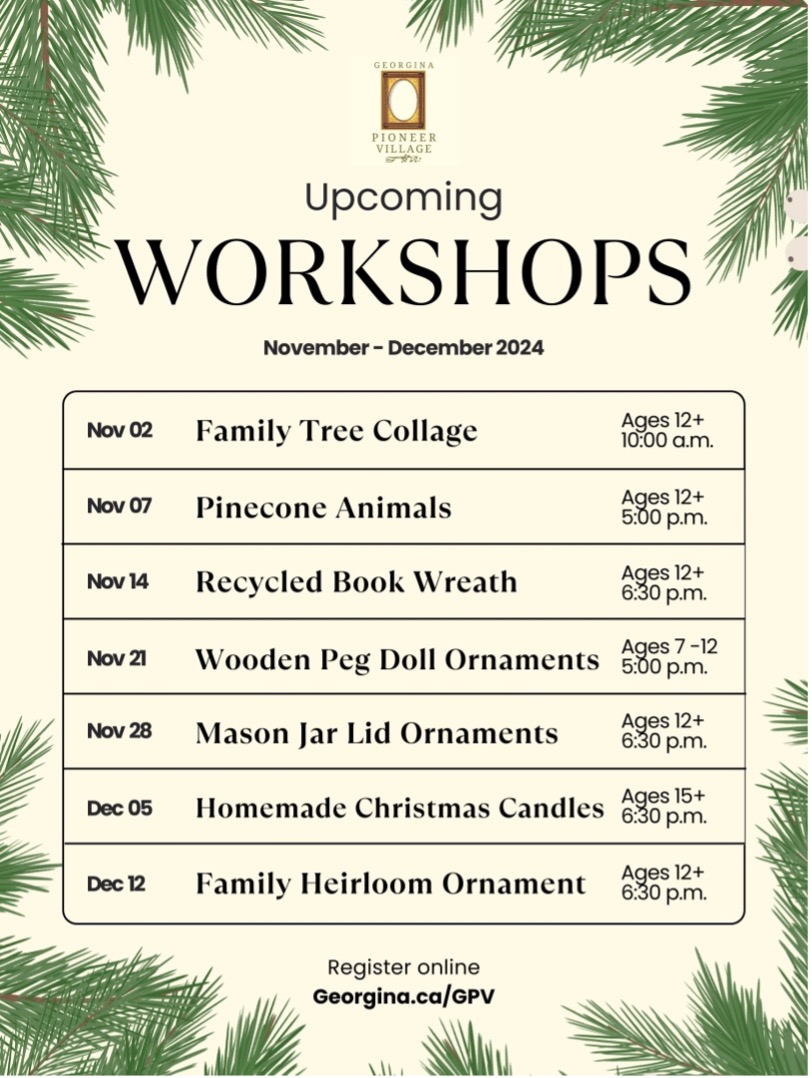
Georgina Pioneer Village Family Fright Night
Saturday, October 19th 4:30 P.M. – 8:30 P.M.
$2.00 per person

